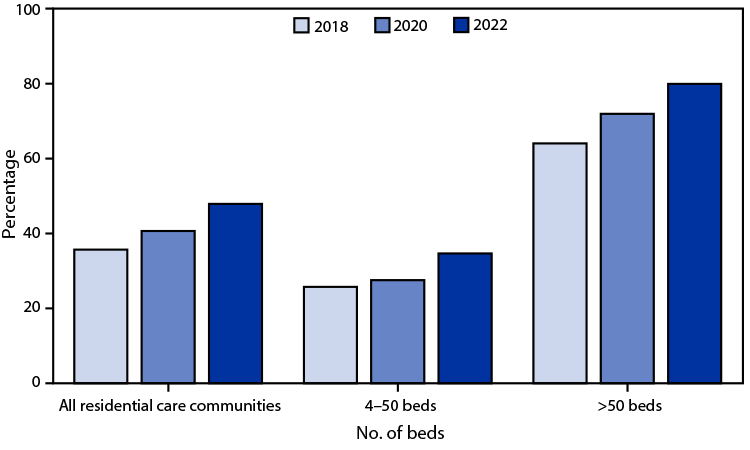Category: residential care communities
QuickStats: Percentage of Residential Care Communities That Use Electronic Health Records, by Community Bed Size — United States, 2018, 2020, and 2022

From 2018 to 2022, the percentage of residential care communities (RCCs) using electronic health records (EHRs) increased from 36% to 48%. Use of EHRs increased during this time regardless of RCC size, and larger RCCs were more likely to use EHRs compared with smaller RCCs. Supplementary Table: https://stacks.cdc.gov/view/cdc/153378 Source: National Center for Health Statistics, National Post-acute and Read More >
Posted on byQuickStats: Percentage of Residential Care Communities that Offer Annual Influenza Vaccination to Residents and to Employees and Contract Staff Members, by Community Bed Size — United States, 2020
In 2020, 87.2% of residential care communities offered annual influenza vaccination to residents, and 77.8% offered annual influenza vaccination to all employees and contract staff members. The percentage of residential care communities offering annual influenza vaccination to residents and to all employees and contract staff members increased with increasing community bed size. The percentage of Read More >
Posted on byQuickStats: Percentage of Residential Care Communities that Use Electronic Health Records, by Community Bed Size — United States, 2016 and 2020
From 2016 to 2020, the percentage of residential care communities using electronic health records increased from 26% to 41%. The percentage using electronic health records increased from 28% to 41% for 11–25 bed communities, 35% to 54% for 26–50 bed communities, 43% to 71% for 51–100 bed communities, and 50% to 74% for more than Read More >
Posted on byQuickStats: Percentage of Residential Care Communities Engaged in Selected End-of-Life and Bereavement Care Practices — National Study of Long-Term Care Providers, United States, 2018
In 2018, when a resident was dying or died, 82% of Residential Care Communities (RCC) documented residents’ family, religious, or cultural preferences in their care plans, 79.9% discussed residents’ spiritual needs with them, 65.1% publicly honored deceased residents in the RCC, and 59.5% offered bereavement services to staff members and residents. Source: National Study of Long-Term Read More >
Posted on byNCHS Releases New Reports on Adult Day Service Centers and Residential Care Communities
New NCHS reports look at national estimates of selected characteristics of residential care community residents and participants of adults day service centers from the 2018 National Study of Long-Term Care Providers. Read More >
Posted on byTrends in electronic health records use among residential care communities: United States 2012, 2014, and 2016
Questions for Christine Caffrey Health Statistician and Lead Author of “Trends in electronic health records use among residential care communities: United States 2012, 2014, and 2016.” Q: Why did you decide to focus on electronic health records use and support for health information exchange among residential care communities? CC: Since how health information is organized Read More >
Posted on byQuickStats: Percentage of Residential Care Communities by U.S. Census Region — National Study of Long-Term Care Providers, 2012–2016
During 2012–2016, the percentage of residential care communities located in the West increased from 36.4% to 40.8%. Throughout the period, a higher percentage of residential care communities were located in the West compared with other regions. The percentage of residential care communities declined from 30.6% in 2012 to 28% in 2016 in the South and Read More >
Posted on byQuickStats: Percentage of Residential Care Community Residents with a Fall, by Census Region — United States, 2016
In 2016, 22% of current residents living in residential care communities had a fall in the past 90 days, representing 175,000 residents in the United States. By region, 27% of residents living in communities in the Northeast, 23% of residents in Midwest communities, and 20% of residents in communities in the South and West, respectively, Read More >
Posted on byQuickStats: Percentage of Residential Care Community Residents with an Advance Directive by Census Division — National Study of Long-Term Care Providers, 2016
In 2016, 77.9% of residents in residential care communities had an advance directive documented in their files. By Census division, the highest percentage (87.8%) of residents who had an advance directive were located in the Mountain division, followed by residents in East North Central (83.7%), New England (80.0%), West North Central (78.9%), Pacific (77.6%), South Read More >
Posted on byQuickStats: Percentage of Residential Care Communities That Use Electronic Health Records by Census Region — United States, 2016
In 2016, 26% of residential care communities used electronic health records (EHRs). The percentage that used EHRs was 36% of communities in the Northeast, 41% of communities in the Midwest, 24% of communities in the South, and 17% of communities in the West. Source: National Study of Long-Term Care Providers, 2016 data. https://www.cdc.gov/nchs/nsltcp/index.htm. https://www.cdc.gov/mmwr/volumes/67/wr/mm6725a8.htm Read More >
Posted on by
